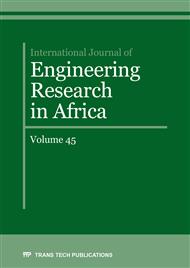[1]
S.K. Bhaumik, R. Rangaraju, M.A. Parameswara, M.A. Venkataswamy, T.A. Bhaskaran and R.V. Krishnan, Fatigue failure of a hollow power transmission shaft. Engineering failure analysis, 2002. 9(4): pp.457-467.
DOI: 10.1016/s1350-6307(01)00033-4
Google Scholar
[2]
R. Li, T.H. Hyde, W. Sun and E.J. Williams, Fatigue crack growth testing of the Super CMV hollow shafts under combined torsional and axial loading. Engineering Failure Analysis, 2014. 36: pp.173-185.
DOI: 10.1016/j.engfailanal.2013.09.021
Google Scholar
[3]
I. Altenberger, Alternative mechanical surface treatments: microstructures, residual stresses & fatigue behavior. Shot Peening, 2006: pp.419-434.
DOI: 10.1002/3527606580.ch54
Google Scholar
[4]
C. Dane, L. Hackel, J. Daly and J. Harrisson, High power laser for peening of metals enabling production technology. Materials and Manufacturing Processes, 2000. 15(1): pp.81-96.
DOI: 10.1080/10426910008912974
Google Scholar
[5]
A. Gill, A. Telang, S. Mannava, D. Qian, Y.-S. Pyoun, H. Soyama and V.K. Vasudevan, Comparison of mechanisms of advanced mechanical surface treatments in nickel-based superalloy. Materials Science and Engineering: A, 2013. 576: pp.346-355.
DOI: 10.1016/j.msea.2013.04.021
Google Scholar
[6]
C. Correa, L.R. de Lara, M. Díaz, A. Gil-Santos, J. Porro and J. Ocaña, Effect of advancing direction on fatigue life of 316L stainless steel specimens treated by double-sided laser shock peening. International Journal of Fatigue, 2015. 79: pp.1-9.
DOI: 10.1016/j.ijfatigue.2015.04.018
Google Scholar
[7]
C.A.V. Jiménez, G.G. Rosas, C.R. González, V.G. Alejo and S. Hereñú, Effect of laser shock processing on fatigue life of 2205 duplex stainless steel notched specimens. Optics & Laser Technology, 2017. 97(Supplement C): pp.308-315.
DOI: 10.1016/j.optlastec.2017.07.020
Google Scholar
[8]
C. Correa, L.R. de Lara, M. Díaz, J. Porro, A. García-Beltrán and J. Ocaña, Influence of pulse sequence and edge material effect on fatigue life of Al2024-T351 specimens treated by laser shock processing. International Journal of Fatigue, 2014. 70: pp.196-204.
DOI: 10.1016/j.ijfatigue.2014.09.015
Google Scholar
[9]
K. Ding and L. Ye, Laser shock peening: performance and process simulation. 2006: Woodhead Publishing.
Google Scholar
[10]
H. Amarchinta, R. Grandhi, K. Langer and D. Stargel, Material model validation for laser shock peening process simulation. Modelling and simulation in materials science and engineering, 2008. 17(1).
DOI: 10.1088/0965-0393/17/1/015010
Google Scholar
[11]
G. Singh, Effective Simulation and Optimization of a Laser Peening Process. 2009, Wright State University.
Google Scholar
[12]
R. Sun, L. Li, Y. Zhu, L. Zhang, W. Guo, P. Peng, B. Li, C. Guo, L. Liu and Z. Che, Dynamic response and residual stress fields of Ti6Al4V alloy under shock wave induced by laser shock peening. Modelling and Simulation in Materials Science and Engineering, 2017. 25(6).
DOI: 10.1088/1361-651x/aa7a46
Google Scholar
[13]
P. Peyre, I. Chaieb and C. Braham, FEM calculation of residual stresses induced by laser shock processing in stainless steels. Modelling and simulation in materials science and engineering, 2007. 15(3): p.205.
DOI: 10.1088/0965-0393/15/3/002
Google Scholar
[14]
R.A. Brockman, W.R. Braisted, S.E. Olson, R.D. Tenaglia, A.H. Clauer, K. Langer and M.J. Shepard, Prediction and characterization of residual stresses from laser shock peening. International Journal of Fatigue, 2012. 36(1): pp.96-108.
DOI: 10.1016/j.ijfatigue.2011.08.011
Google Scholar
[15]
SIMULIA, Continuum Elements. In Guide, A.a.U.S. (Ed.) 6.20. 2017. Online.
Google Scholar
[16]
P. Peyre, L. Berthe, V. Vignal, I. Popa and T. Baudin, Analysis of laser shock waves and resulting surface deformations in an Al–Cu–Li aluminum alloy. Journal Of Physics D: Applied Physics, 2012. 45(33): p.335304.
DOI: 10.1088/0022-3727/45/33/335304
Google Scholar
[17]
G. Singh, Effective Simulation and Optimization of a Laser Peening Process. 2009, Wright State University.
Google Scholar
[18]
C. Correa, D. Peral, J. Porro, M. Díaz, L.R. de Lara, A. García-Beltrán and J. Ocaña, Random-type scanning patterns in laser shock peening without absorbing coating in 2024-T351 Al alloy: a solution to reduce residual stress anisotropy. Optics & Laser Technology, 2015. 73: pp.179-187.
DOI: 10.1016/j.optlastec.2015.04.027
Google Scholar
[19]
S.G. Irizalp and N. Saklakoglu, 1.14 Laser Peening of Metallic Materials. Comprehensive Materials Finishing, 2016: p.408.
DOI: 10.1016/b978-0-12-803581-8.09160-8
Google Scholar
[20]
G. Singh, R.V. Grandhi, W.S.U.D.O.D.o. MECHANICAL and M. ENGINEERING., Laser Peening for Reliable Fatigue Life. Delivery Order 0025: Volume 1 - Simulation and Optimization of a Laser Peening Process. 2009: Defense Technical Information Center.
DOI: 10.21236/ada550435
Google Scholar
[21]
H. Amarchinta, Uncertainty Quantification Of Residual Stresses Induced By Laser Peening Simulation. 2010, Wright State University.
Google Scholar
[22]
G. Singh, R.V. Grandhi and D.S. Stargel, Modeling and parameter design of a laser shock peening process. International Journal for Computational Methods in Engineering Science and Mechanics, 2011. 12(5): pp.233-253.
DOI: 10.1080/15502287.2010.542795
Google Scholar
[23]
A. Vasu, K. Gobal and R.V. Grandhi, A computational methodology for determining the optimum re-peening schedule to increase the fatigue life of laser peened aircraft components. International Journal of Fatigue, 2015. 70: pp.395-405.
DOI: 10.1016/j.ijfatigue.2014.07.008
Google Scholar
[24]
T. Nam, Finite Analysis of Residual Stress Field Induced by Laser Shock Peening, in Department of Mechanical Engineering. 2002, Ohio State University.
Google Scholar
[25]
S. Kumar, R. Rao and B. Rajeevalochanam, Current Practices in Structural Analysis and Testing of Aero-Engine Main Shafts. Procedia Engineering, 2013. 55: pp.499-509.
DOI: 10.1016/j.proeng.2013.03.287
Google Scholar
[26]
V. Granados-Alejo, C. Rubio-González, C. Vázquez-Jiménez, J. Banderas and G. Gómez-Rosas, Influence of specimen thickness on the fatigue behavior of notched steel plates subjected to laser shock peening. Optics & Laser Technology, 2017. 101: pp.531-544.
DOI: 10.1016/j.optlastec.2017.12.011
Google Scholar
[27]
N. Hfaiedh, P. Peyre, H. Song, I. Popa, V. Ji and V. Vignal, Finite element analysis of laser shock peening of 2050-T8 aluminum alloy. International Journal of Fatigue, 2015. 70: pp.480-489.
DOI: 10.1016/j.ijfatigue.2014.05.015
Google Scholar


